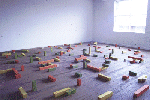| Andrew
McQualter tree; pier and ocean |
||

|
. . .He would imagine
optical law as something that is itself submitted to
a code, digitised by the higher laws of intellect . .
. His field would be structured by those signals,
these signs for plus and minus, these fragments of an
abstract grid that would intend to throw its net over
the whole of the external world in order enter it
into consciousness. To think it. Rosalind Krauss RECENTLY, I've become interested in digital code. I was having a conversation with somebody on the tram about research they were doing into philosophical concepts of time in relation to theories of modernity (this don't happen everyday) . . . and I brought up the subject of digital code at some point in the conversation where it seemed relevant. I was trying to express some vague ideas about the developments in science, mathematics and technology being parallel to those in the visual arts, especially with modernism. I'd been wondering if there wasn't a link between - say, the scientific belief that nature is governed by a series of mathematical codes (a belief spurred on by such discoveries as the fibbonachi numbers 1202, which are said to govern the growth of plants. . .) - and the gradual reduction of visual data to a series of lines and planes in the development of abstract painting. I was about to get off the tram when the guy I'd been talking to said - ". . . but isn't that what we are doing now, using language? Using a series of signs for positive and negative?" Maybe language is a kind of code. In infants school we were given sets of tiny coloured blocks called "cuisenaire rods". Georges Cuisenaire invented the rods in the early fifties, and they bought about a revolution in maths education. The brightly coloured rods enabled young children to quickly master mathematical knowledge by providing a physical representation of an abstract concept. What would lead to the development of such an ingenious method of teaching mathematics (one that would make mathematics "as natural as language"?)1 Was it the belief that mathematics was the language of the future? Maybe this is similar to Mondrian's development of abstract painting. He started out with abstractions from natural forms (a tree in 1914, the surface of the ocean in the years 1917-19) 0 you might say that he was a scientist of visuality, carrying out a series of experiments in order to discover a transcendent code that not only expressed the absolute structure that lay behind things in the world, but also the sensation of perceiving the world as such. I think about Mondrian staring at the sea Andrew McQualter endotes © The artist,
writers and |
|